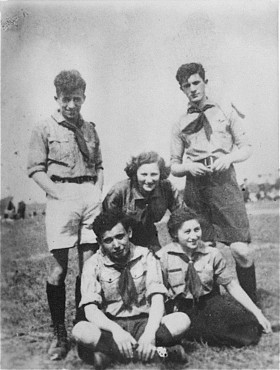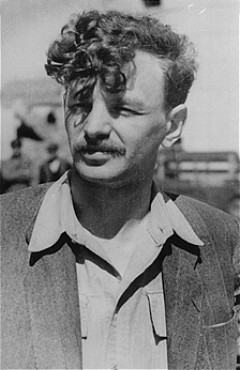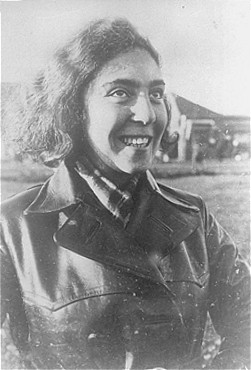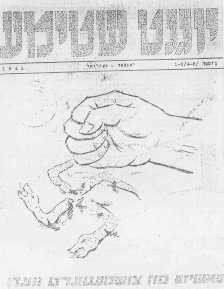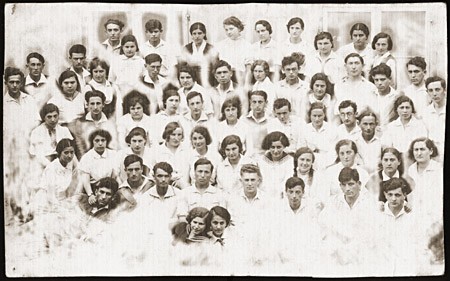
Jewish Youth Movements in Wartime Poland: From Minority to Leadership
A Project of the Miles Lerman Center
Introduction
In many cities immediately before World War II (Kalisz, for instance), Zionist groups occupied at best a secondary status behind other Jewish political organizations with different orientations and aims, such as the socialist Bundist party or the traditionalist Agudath Israel party, which represented Poland’s sizable Orthodox Jewish population. During the war, however, members of Zionist youth movements embraced leadership positions in ghetto resistance and partisan fighting organizations.
Flight and Return
At the beginning of the war in September 1939 most of the official Polish Jewish leadership either fled Warsaw and the other major cities of Poland for the Soviet Union or abroad or were captured, imprisoned, and executed. Some of those leaders who did stay behind during the war were forced to participate in the Judenrat (Jewish council) of their cities and towns during the war.
After the start of the war, however, a number of Zionist youth leaders who had managed to flee to the east made the decision to return to occupied Poland. This was the case among the youth movement leadership of Warsaw. Many of them had fled to Vilna in order to escape the Nazi invasion in September 1939. Youth leaders of movements like Hashomer Hatzair, Dror, Betar, and He-Halutz such as Mordechai Anilewicz , Zivia Lubetkin, Yitzhak Zuckerman, Josef Kaplan, Frumka Plotnicka, Tosia Altman, and Samuel Breslaw elected to return voluntarily after several months spent in Russia and Lithuania. The youth movement leaders who returned to Warsaw were motivated by a sense of responsibility as local leaders, not only to their young chanichim (movement members), but to the Jewish community as a whole.
A Broader Responsibility
Under the German occupation, organized Zionist youth worked to better understand the needs of a wider Jewish public. Before the war, their activities had been focused on the “elite” among Jewish youth training for aliyah to Palestine. During the war their sense of responsibility and range of activities broadened. As part of their educational efforts, Zionist youth movements established kibbutz groups and underground schools in the ghettos.
Through continued activity during the war, communication between ghettos, and the establishment of an underground press, Zionist youth groups were able to maintain better organization of their movements than other political groups (which collapsed or were greatly weakened under the weight of German persecution and exterminatory policies). Tosia Altman, for example, spent the first half of 1940 traveling to the various Hashomer Hatzair branches in the Generalgouvernement and Galicia to assist in organizing the movement.
An Alternative Leadership
These youth movement leaders in turn became the leaders of the ghetto resistance and took the initiative in determining political and social action underground. Before the war, the youth movements were largely dependent on shlichim (emissaries) from Palestine in determining policy formation.
During the war, however, the youth movements were largely cut off from the outside world and were far more independent and autonomous than before. They functioned as a source of information from the outside world, emerging as an alternative leadership organization to the Jewish council.
The youth movement leaders, because they were indeed younger than the other political leaders, were not confronted with the impossibly difficult task of serving on the Jewish council. Nonetheless, the youth movements quickly became highly critical of the Jewich council and Jewish police, often making them the first targets of both their political and physical attacks in the ghetto underground.
In many cases, the youth movements were often the first to assess the early Jewish massacres as part of a comprehensive program, and were thus instrumental in the early organization of resistance. The mobility of the youth movement leadership also enabled them to publicize the first news of atrocities in Lithuania, as was the case in Tosia Altman’s return from Vilna to Warsaw in late 1941. Even so, many in the youth movements were highly critical of themselves after the war for neither recognizing the danger nor organizing resistance earlier.
After the War
Notwithstanding such self-criticism, their actions during the time of German occupation placed the youth movements in an excellent position to assume a leadership position following the war, both in their own eyes and in the eyes of other survivors.
Critical Thinking Questions
- What dilemmas faced the leaders and members of Jewish youth movements?
- How can societies, communities, and individuals reinforce and strengthen the willingness to stand up for others?


